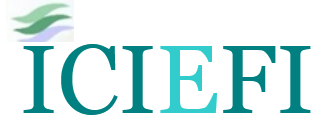Determinant of FDI Inflows in OIC Countries
Abstract
This study aims to analyze the determinants of foreign direct investment (FDI) in the Organization of Islamic Cooperation (OIC) country members for the period 2005 to 2018 The determinant variables of FDI are corruption, political stability and macroeconomic variables such as inflation, exchange rates, economic growth, and trade openness. Analysis used in the study is the fixed effect model (FEM) of the OIC data panel.
The results showed that economic growth and trade openness had a significant influence on foreign direct investment (FDI), while the effects of corruption, political stability, inflation and the exchange rate have no significant effect on foreign direct investment (FDI).
Full Text:
PDFReferences
Alshamsi, K., Hussin, M., & Azam, M. (2015). The impact of inflation and. Investment management & financial innovations GDP per capita on foreign direct investment: the case of United Arab Emirates., 132-141. Retrieved May 4, 2020, from https://businessperspectives.org/images/pdf/applications/publishing/templates/article/assets/6875/imfi_en_2015_03cont_Alshamsi.pdf
Aggarwal, R. (2003). Allocation of initial public offerings and flipping activity. Journal of Financial Economics, 68(1), 111-135. Retrieved May 1, 2020, from https://www.sciencedirect.com/science/article/abs/pii/S0304405X02002507
Ake, C. (1975). A Definition of political stability. Comparative Politic, 7(2), 271-283. Retrieved May 2, 2020, from https://www.jstor.org/stable/421552?seq=1
Alshamsi, K. H., Hussin, M. R., & Azam, M. (2017). The impact of inflation and GDP per capita on foreign direct investment: the case of United Arab Emirates. Investment management and financial innovations, 12, 132-141. Retrieved May 1, 2020, from https://www.semanticscholar.org/paper/The-impact-of-inflation-and-GDP-per-capita-on-the-Alshamsi-Hussin/b1aec1927b9f0d2ccbca212ae13d4da91d858c16
Anggarwal, R., Prabhala, N. R., & Puri, M. (2002). Institutional Allocation in Initial Public Offerings: Empirical Evidence. The Journal of Finance, 1421-1442. Retrieved May 2, 2020, from https://www.nber.org/papers/w9070
Appleyard, D., Field, A., & Cobb, S. (2014). International Economics. New York: The McGraw-Hill series economics.
Asamoah, M. E., Adjasi, C. K., & Alhassan, A. L. (2016). Macroeconomic Uncertainty, Foreign Direct Investment and Institutional Quality: Evidence from Sub-Saharan Africa. Economic Systems, 612-621. Retrieved May 3, 2020, from https://www.sciencedirect.com/science/article/abs/pii/S0939362516300759#:~:text=The%20study%20examines%20the%20moderating,investment%20in%20Sub%2DSaharan%20Africa.&text=The%20results%20show%20that%20macroeconomic,increases%20the%20flow%20of%20FDI.
Asiedu, E. (2013). Foreign Direct Investment, Natural Resources and Institutions. International Growth Centre. Retrieved May 2, 2020, from https://www.theigc.org/wp-content/uploads/2014/09/Asiedu-2013-Working-Paper.pdf
Baltagi, B. H. (2005). Econometric Analysis of Panel Data. London: John Wiley & Sons Ltd.
Boateng, A., Hua, X., Nisar, S., & Wu, J. (2015). Examining the determinants of inward FDI: Evidence from Norway. Economic Modelling, 47, 118-127. Retrieved May 1, 2020, from https://www.sciencedirect.com/science/article/abs/pii/S0264999315000358
Canare, T. (2017). The effect of corruption on foreign direct investment inflows : Evidence from a panel of Asia-Pacific countries. The Changing Face of Corruption in the Asia Pacific:Curent Perspectives and Future Challenges, 35-55. Retrieved May 3, 2020, from https://www.sciencedirect.com/science/article/pii/B9780081011096000034
Case, K. E., Fair, R. C., & Oster, S. E. (2007). Principles of economics. London: Pearson.
Dhomar, E. D. (1946). Capital Expansion, Rate of Growth, and Employment. Econometrica, 14(2), 137-147. Retrieved May 3, 2020, from https://www.jstor.org/stable/1905364
Gangi, Y. A., & Abdulrazak, R. S. (2012). The impact of governance on FDI flows to African countries. World Journal of Entrepreneurship, Management and Sustainable Development, 8(2/3), 162-169. Retrieved May 1, 2020, from https://www.emerald.com/insight/content/doi/10.1108/20425961211247761/full/html
Ghairabeh, A. M. (2015). The Determinants of Foreign Direct Investment Empirical Evidence from Bahrain. International Journal of Business and Social Science, 6(8). Retrieved May 1, 2020, from http://ijbssnet.com/journals/Vol_6_No_8_August_2015/11.pdf
Global Investment Competitiveness. (2017). Retrieved from http://documents.worldbank.org/curated/en/169531510741671962/Global-investmentcompetitiveness-report-2017-2018-foreign-investor perspectives-and-policy-implications.
Goldbreg, L., & Kolstad, C. (1995). Foreign Direct Investment, Exchange Rate Variability and Demand Uncertainty. 36(4), 855-873. Retrieved April 30, 2020, from https://www.jstor.org/stable/2527262?seq=1
Harrord, R. (1939). An Essay in Dynamic Theory. The Economic Journal, 49(193), 14-33. Retrieved May 1, 2020, from http://piketty.pse.ens.fr/files/Harrod1939.pdf
Hausman, R., & Fernández-Arias, E. (2000). Foreign Direct Investment: Good Cholesterol? IDB Working Paper. Retrieved May 4, 2020, from https://papers.ssrn.com/sol3/papers.cfm?abstract_id=1817215
Howell, L., & Chaddick, B. (1994). Models of Political Risk for Foreign Investment and Trade: An Assessment of Three Approaches. The Columbia Journal of World Business, 29(3), 70-91. Retrieved May 3, 2020, from https://www.sciencedirect.com/science/article/abs/pii/0022542894900485
Hsiao, C. (2007). Panel Data Analysis-Advantages and Challenges. Mathematics Subject Classification. Retrieved May 2, 2020, from https://link.springer.com/article/10.1007/s11749-007-0046-x
Jadhav, P. (2012). Determinants of Foreign Direct Investment in BRICS Economics: Analysis of Economic, Institutional and Political Factor. Procedia - Social and Behavioral Sciences, 37, 5-14. Retrieved April 29, 2020, from https://www.sciencedirect.com/science/article/pii/S1877042812007495
Jaspersen, F., Aylward, A., & Knox, A. (2000). Risk and Private Investment: Africa Compared with Other Developing Areas. Investment and Risk in Africa, 71-95. Retrieved April 29, 2020, from Investment and Risk in Africa
Kahneman , D., & Tversky, A. (1979). Prospect Theory: An Analysis of Decision under Risk. Econometrica, 47(2), 263-292. Retrieved May 1, 2020, from https://www.jstor.org/stable/1914185?seq=1
Karim, B. A., Karim, Z. A., & Nasharuddin, M. (2018). Corruption and Foreign Direct Investment ( FDI) in ASEAN-5 : A Panel Evidence. Economics and Finance in Indonesia, 64(2), 145-156. Retrieved May 3, 2020, from http://efi.ui.ac.id/index.php/efi/article/view/594
Krugman, P. R., Obstfeld , M., & Melitz, M. J. (2012). International Economics: Theory & Policy, Global Edition. London: The Pearson.
Kumari, R., & Sharma , A. (2017). Determinants of foreign direct investment in developing countries: a panel data study. International Journal of Emerging Markets, 12(4), 658-682. Retrieved May 3, 2020, from https://www.emerald.com/insight/content/doi/10.1108/IJoEM-10-2014-0169/full/html
Kurul, Z., & Yalta, A. (2017). Relationship between institutional factors and FDI flows in developing countries: New evidence from dynamic panel estimation. Economies, 5(2), 1-10. Retrieved May 5, 2020, from https://www.mdpi.com/2227-7099/5/2/17
Mankiw, N. (2008). Principle of Macroeconomics. Boston: Cengange Learning.
Mishkin, F. (2008). The Economics Of Money Banking And Financial Markets. London: Pearson.
Moosa, I. (2004). International Finance. Melbourne: La Trobe Unversity.
Nye, J. (1967). Corruption and political development: A cost benefit analysis. The American Political Science Review,, 61(2), 417-427. Retrieved April 30, 2020, from https://www.jstor.org/stable/1953254?seq=1
Othman, Z., Shafie, R., & Hamid, F. (2014). Corruption – Why do they do it? Procedia - Social and Behavioral Sciences, 248-257. Retrieved May 3, 2020, from https://www.sciencedirect.com/science/article/pii/S1877042814058947
Samuelson, P., & Nordhaus, W. (2001). Macroeconomics. New York: McGraw-Hill Higher Education.
Tintin, C. (2013). The determinants of foreign direct investment inflows in the Central and Eastern European Countries: The importance of institutions. Communist and Post-Communist Studies, 46(2), 287-298. Retrieved April 30, 2020, from https://www.sciencedirect.com/science/article/abs/pii/S0967067X13000159
Udenze, O. (2014). The Effect of Corruption on Foreign Direct Investments in Developing Countries. The Park Place Economist, 87-95. Retrieved May 4, 2020, from https://digitalcommons.iwu.edu/cgi/viewcontent.cgi?article=1416&context=parkplace&httpsredir=1&referer=
Ullah, I., & Khan, M. (2017). Institutional quality and foreign direct investment inflows: evidence from Asian countries. Journal of Economic Studies, 44, 1030-1050. Retrieved May 1, 2020, from https://www.emerald.com/insight/content/doi/10.1108/JES-10-2016-0215/full/html
Wooldridge, J. (2002). Econometric Analysis of Cross Section and Panel Data. Massachusetts: The MIT Press.
World Bank. (2018). World Bank List of Economies. Retrieved July 20, 2019, from http://data.worldbank.org/indicator
Xaypanya , P., Rangkakulnuwat , P., & Paweenawat , S. (2015). The determinants of foreign direct investment in ASEAN. International Journal of Social Economics, 239-250. Retrieved May 5, 2020, from https://www.emerald.com/insight/content/doi/10.1108/IJSE-10-2013-0238/full/html
DOI: https://doi.org/10.18196/ijief.v4i1.9473
Refbacks
- There are currently no refbacks.
Copyright (c) 2021 International Journal of Islamic Economics and Finance (IJIEF)

This work is licensed under a Creative Commons Attribution-ShareAlike 4.0 International License.
International Journal of Islamic Economics and Finance (IJIEF)
International Program for Islamic Economics and Finance
Department of Economics
Faculty of Economics and Business
Universitas Muhammadiyah Yogyakarta
Pascasarjana Building, Ground Floor
Jl. Brawijaya (Ringroad Selatan), Kasihan, Bantul
D.I. Yogyakarta 55183, INDONESIA
Official email: ijief@umy.ac.id












1.jpg)